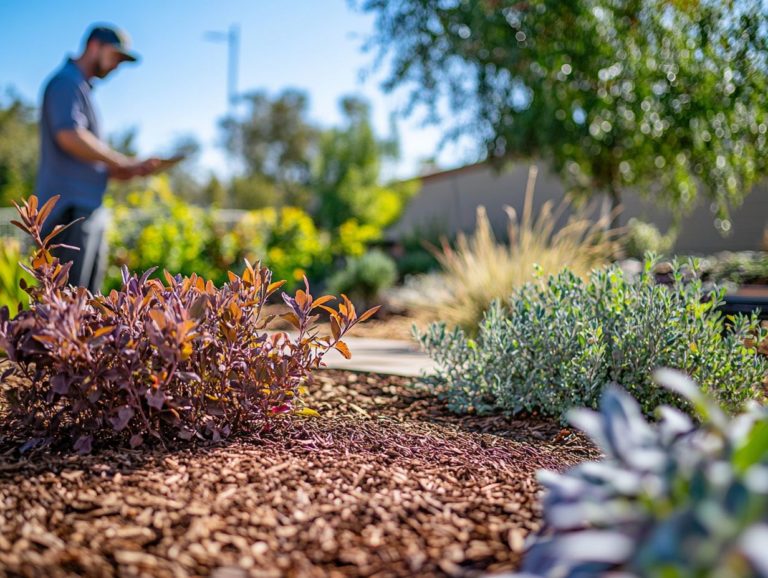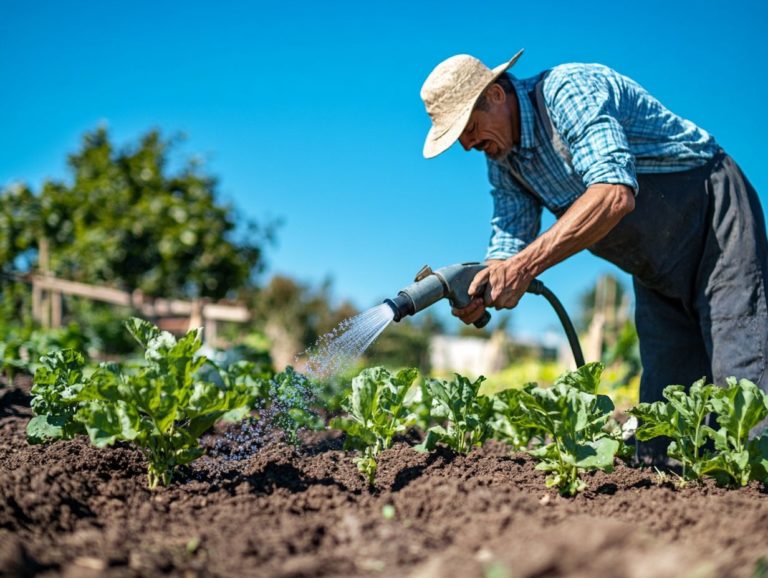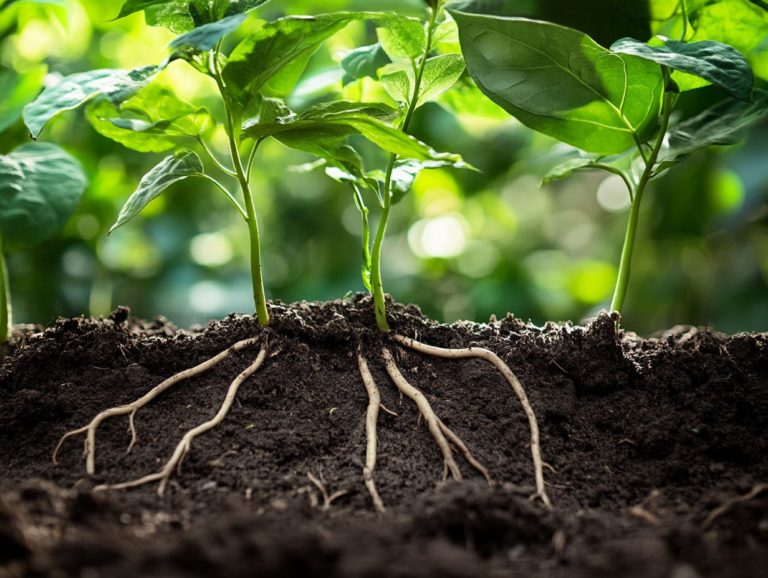How to Approach Seasonal Garden Clean-Up
Seasonal garden clean-up might feel overwhelming, but with the right strategy, it can become a fulfilling endeavor.
This guide will lead you through essential steps. Gather your tools, craft a solid plan, and tackle vital tasks like removing dead plants and pruning.
Uncover effective methods for responsibly disposing of debris, including composting and recycling. You will also find valuable tips for maintaining a clean and thriving garden throughout the year. This comprehensive guide offers expert-approved tips and best practices to ensure your yard cleanup is both effective and thorough.
Are you ready to transform your outdoor space? Let s get started on transforming your outdoor space!
Contents
- Key Takeaways:
- Preparing for Seasonal Garden Clean-Up
- Tasks to Tackle During Clean-Up
- Proper Disposal of Debris
- Maintaining a Clean and Healthy Garden
- Frequently Asked Questions
- What happens during seasonal garden clean-up?
- When should I start my seasonal garden clean-up?
- What tools do I need for seasonal garden clean-up?
- How do I dispose of the debris collected during seasonal garden clean-up?
- Do I need to remove all plant debris during seasonal garden clean-up?
- How Often Should I Do Seasonal Garden Clean-Up?
Key Takeaways:
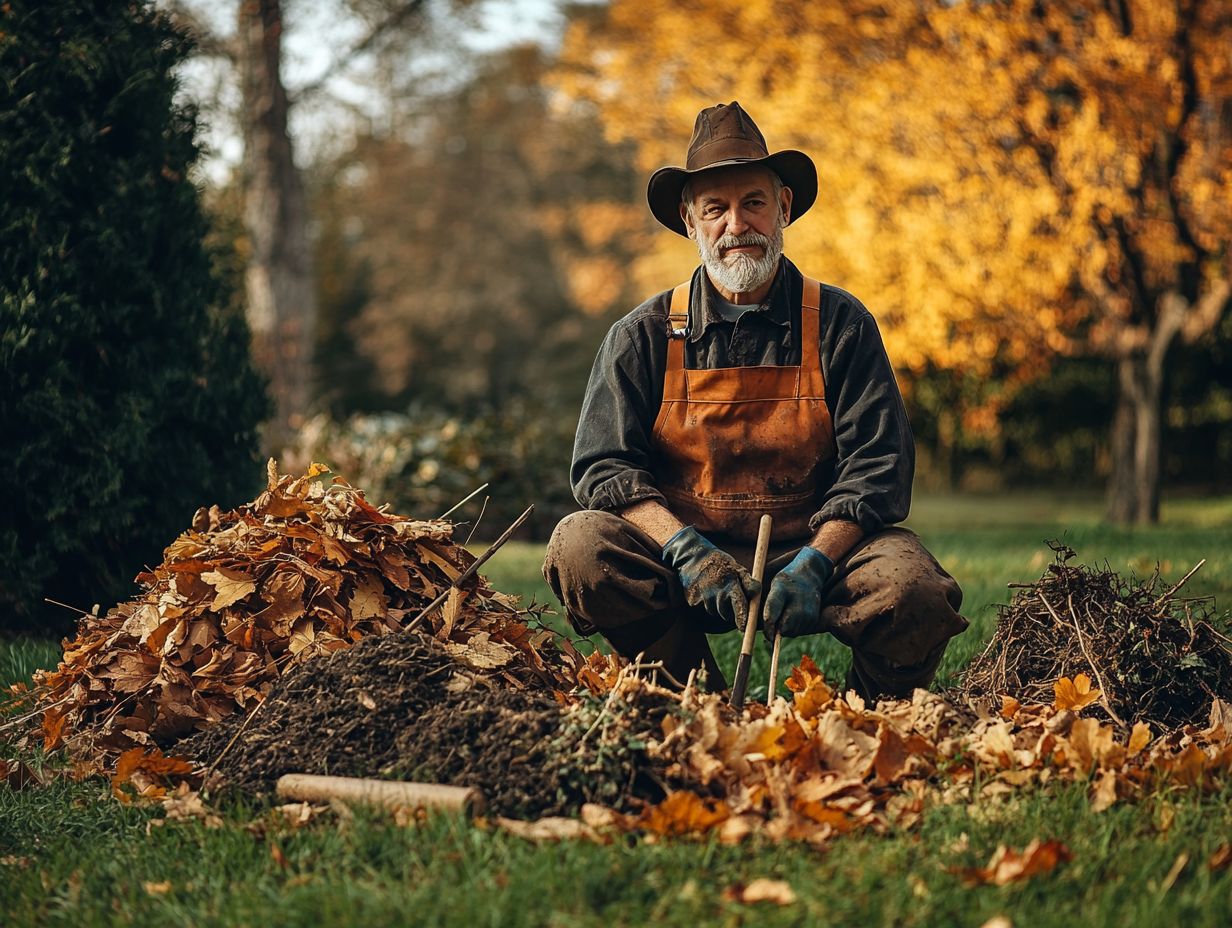
- Gather all necessary tools and supplies before starting seasonal garden clean-up to avoid interruptions and save time.
- Create a plan of action for tackling tasks such as removing dead plants, pruning, and organizing garden beds to stay organized and efficient.
- Properly dispose of debris by composting or recycling non-organic waste to maintain a clean and healthy garden and prevent future clutter and weeds with regular maintenance tasks.
Preparing for Seasonal Garden Clean-Up
Preparing for seasonal garden cleanup is essential for a vibrant and healthy landscape, especially during winter or spring cleanup. Embrace these practices all year round, whether you re readying for winter s chill or planning your spring rejuvenation.
This comprehensive guide offers expert-approved tips and best practices to ensure your yard cleanup is both effective and thorough.
Discover insights on composting, pruning, and more! By turning your kitchen scraps and garden debris into nutrient-rich compost, you can cultivate a thriving ecosystem that nurtures beautiful plant life. Pruning dead branches and implementing DIY lawn care strategies like making soil less compact and planting new grass seeds will enhance your garden.
Embrace these practices to elevate your outdoor space and enjoy a flourishing garden season after season.
Gather Necessary Tools and Supplies
Gathering your tools is the first step towards a successful garden cleanup! To effectively carry out your seasonal garden cleanup, it s essential to gather the right tools and supplies. These will not only assist you in your yard cleanup efforts but also streamline the entire process.
Utilizing key tools like pruning shears, rakes, shovels, and compost bins is vital for maintaining your garden while responsibly recycling organic waste. Pruning shears are essential for trimming overgrown plants, keeping your garden flourishing and warding off disease. Rakes help you efficiently gather leaves and debris, making it a breeze to prepare your garden beds for the upcoming seasons.
Shovels allow you to dig and relocate soil or compost, enhancing aeration and drainage. Compost bins transform your kitchen scraps and garden trimmings into nutrient-rich soil amendments through decomposition. By implementing these expert-approved tips, you can truly elevate the quality of your lawn care and gardening endeavors.
In summary, seasonal garden cleanup is vital for maintaining the beauty and health of your outdoor space. By applying what you ve learned, you can ensure your garden flourishes year-round!
Create a Plan of Action
Creating a plan of action for your seasonal garden cleanup will allow you to systematically address every corner of your yard, ensuring you tackle essential tasks like weed removal and pest prevention.
By breaking down your objectives into manageable steps, you can craft a checklist that aligns with the unique needs of your garden as the seasons shift. Consider crucial factors such as soil condition, plant health, and local climate trends, as these elements will profoundly impact your cleaning strategy.
Engaging with expert-approved tips like scheduling regular assessments and incorporating composting into your routine can significantly enhance your efficiency. By allocating your time wisely, you ll cultivate a more organized approach that leads to a flourishing garden season after season.
Prioritizing tasks amplifies productivity and guarantees that nothing vital slips through the cracks during the bustling cleanup period.
Tasks to Tackle During Clean-Up
During seasonal garden cleanup, it’s crucial to engage in a variety of tasks that will bring new life into your landscape. Essential activities include:
- removing weeds
- pruning away dead branches
- cleaning and organizing your garden beds
Each task contributes to the overall revitalization of your outdoor space, ensuring it flourishes beautifully in the upcoming season.
Removing Dead Plants and Weeds
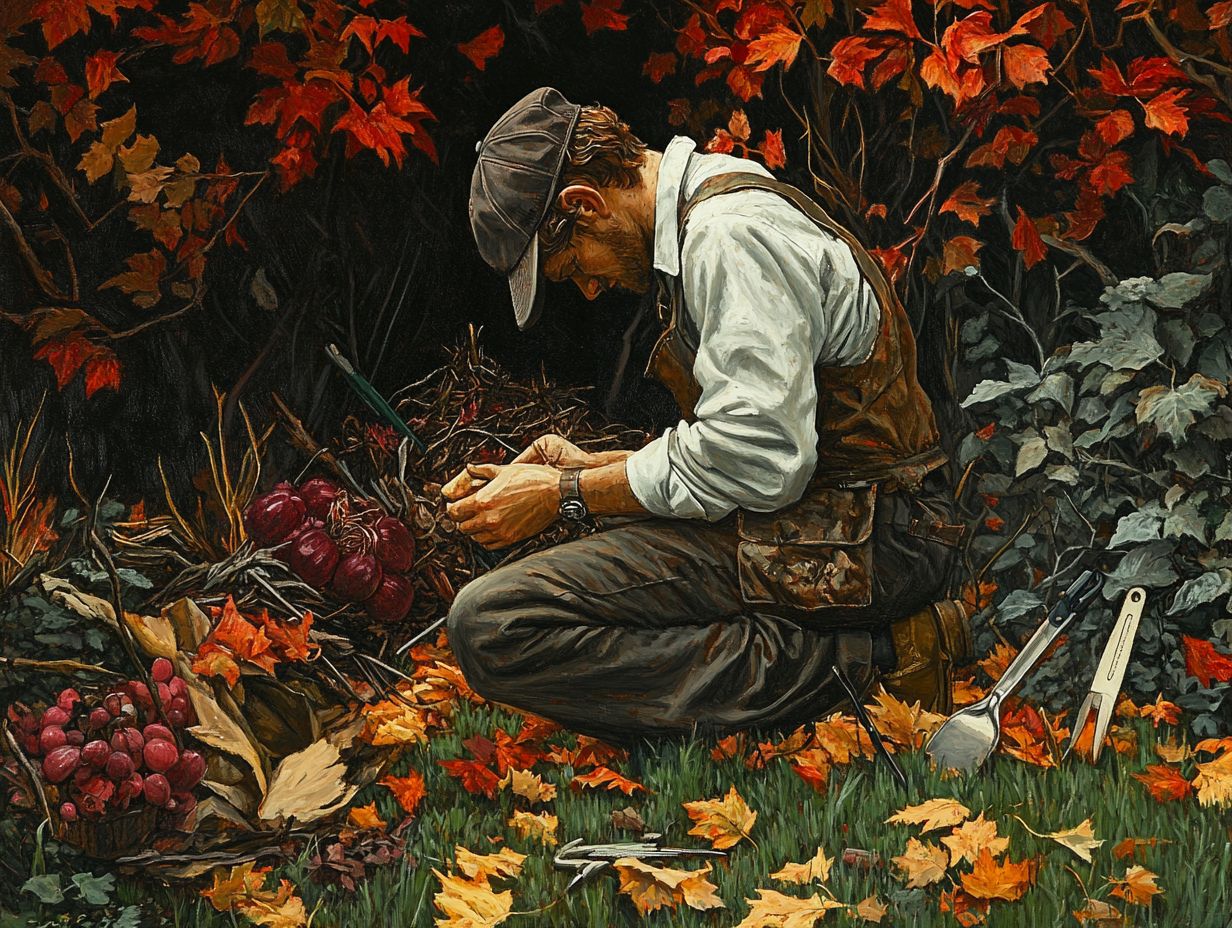
Removing dead plants and weeds is an important step in your seasonal garden cleanup. It promotes the health of your plants and prepares your garden for exciting new growth.
To achieve the best results, take the time to identify troublesome weeds that compete with your plants for vital nutrients and resources. Begin by pulling them out when they’re still young; they re easier to remove at this stage and less likely to spread their seeds. Always check for signs of disease before disposing of dead plants. This precaution helps prevent any pathogens from taking hold in your garden.
Don’t miss out on the benefits of composting your garden waste! Not only does this practice reduce what you send to the landfill, it also enriches the soil. By returning decomposed organic matter to the earth, you enhance its nutrient content, creating a flourishing ecosystem for future growth. This approach aids in effective weed control and ensures a sustainable environment for your healthy plants to thrive.
Pruning and Trimming
Pruning and trimming during seasonal garden cleanup are essential for keeping your plants healthy and elevating the overall beauty of your garden.
Timing is just as crucial as technique, as different plant types demand specific approaches for the best results. For example, spring-blooming shrubs should be pruned right after they flower to ensure that their blooms return next season, while summer-flowering varieties thrive with early spring trimming.
When removing dead branches, using clean, sharp tools is vital. This promotes quick healing and reduces the risk of disease. Experts suggest cutting at an angle just above a node, which is the part of the stem where new growth appears, to encourage new growth.
Incorporating sustainable practices like composting pruned material not only minimizes waste but also enriches your soil health. By mastering these techniques, you can play a significant role in cultivating a vibrant and thriving ecosystem in your garden.
Cleaning and Organizing Garden Beds
Cleaning and organizing your garden beds is a crucial part of seasonal garden cleanup, laying the groundwork for effective composting of garden waste and the application of mulch.
This process consists of several important steps to ensure your garden remains vibrant and healthy. First, it’s essential to clear away debris like fallen leaves, dead plants, and pesky weeds. This allows sunlight and air to reach the soil, promoting overall health. Once your space is clear, applying a layer of mulch serves dual purposes: it conserves moisture and helps suppress weeds while regulating soil temperature.
Next, organizing your perennials and annuals creates a harmonious growth environment, preventing overcrowding and enabling your plants to truly thrive. A well-organized garden elevates its appeal and promotes plant health.
Proper Disposal of Debris
Proper disposal of debris is essential during your seasonal garden cleanup. Keeping your yard looking pristine is essential. It also allows you to utilize composting options effectively, minimizing waste.
Composting Options
Composting options for garden waste present a remarkable opportunity for you to recycle organic matter. By turning your kitchen scraps and yard debris into nutrient-rich compost, you can cultivate a thriving ecosystem that nurtures vibrant plant life.
The composting process typically involves layering green materials, like grass clippings and vegetable scraps, with brown materials, such as dried leaves and cardboard. This thoughtful blend encourages helpful bacteria to effectively break down organic materials.
Act now to maintain the right balance of moisture and aeration for a thriving compost pile! Not only does composting enrich your soil with vital nutrients, but it also improves its structure, helping to retain moisture and enhance drainage. In turn, this leads to healthier, more resilient plants flourishing in your garden.
Recycling and Disposing of Non-Organic Waste

Recycling and disposing of non-organic waste is a crucial part of your seasonal garden cleanup, playing a pivotal role in pest prevention and environmental sustainability.
To effectively identify non-organic materials, you should familiarize yourself with common items like plastics, metal cans, and glass materials that don t biodegrade and can harm the ecosystem if discarded improperly.
Implement best practices for recycling these materials:
- Sort waste at the source
- Rinse containers to remove residues
- Check local guidelines for collection dates and drop-off locations
By ensuring that non-organic waste is disposed of correctly, you not only protect the environment but also create a habitually clean garden that deters pests and unwanted animals, promoting a healthier outdoor space.
Proper waste management ultimately establishes a sustainable cycle that benefits both the environment and the wellbeing of your garden.
Maintaining a Clean and Healthy Garden
Maintaining a clean and healthy garden demands more than just seasonal tidying! You need to implement effective strategies for pest prevention and engage in regular maintenance tasks that promote soil health.
This ongoing effort is essential for creating a vibrant and resilient garden that thrives throughout the seasons. Get ready to transform your garden into a vibrant retreat!
Tips for Preventing Future Clutter and Weeds
Implementing effective strategies to prevent future clutter and weeds will ensure that your seasonal garden cleanup efforts yield long-lasting results and promote healthy plants.
By strategically utilizing landscape fabric and cover crops, you can significantly reduce garden maintenance throughout the year. Landscape fabric serves as a protective barrier, inhibiting weed growth while allowing essential nutrients and moisture to reach the plants below.
Cover crops, in contrast, enrich the soil and suppress unwanted weeds during the off-seasons. Using pest prevention methods, such as companion planting (growing different plants together to help each other) and natural insect repellents, will cultivate a harmonious environment in your garden, enhancing productivity and building resilience against invasive species.
Embracing these strategies will elevate the visual appeal of your garden and contribute to a thriving ecosystem.
Regular Maintenance Tasks to Keep Your Garden Clean
Regular maintenance tasks are essential for keeping your garden clean and thriving. These tasks make your seasonal garden cleanup not only more effective but also manageable.
Engaging in activities like weeding, mulching, and watering plays a crucial role in fostering healthy plant growth while warding off pests. Regular weeding helps keep your garden looking pristine and minimizes competition for nutrients among your plants.
Meanwhile, mulching works wonders by retaining soil moisture and suppressing unwanted weed growth. Consider investing in an efficient lawn care subscription to ensure these vital tasks are completed consistently.
This smart choice saves you time and gives your garden the care it deserves while enhancing your home s curb appeal and prolonging the life of your plants. Ultimately, it transforms your outdoor space into a vibrant oasis.
Frequently Asked Questions
What happens during seasonal garden clean-up?
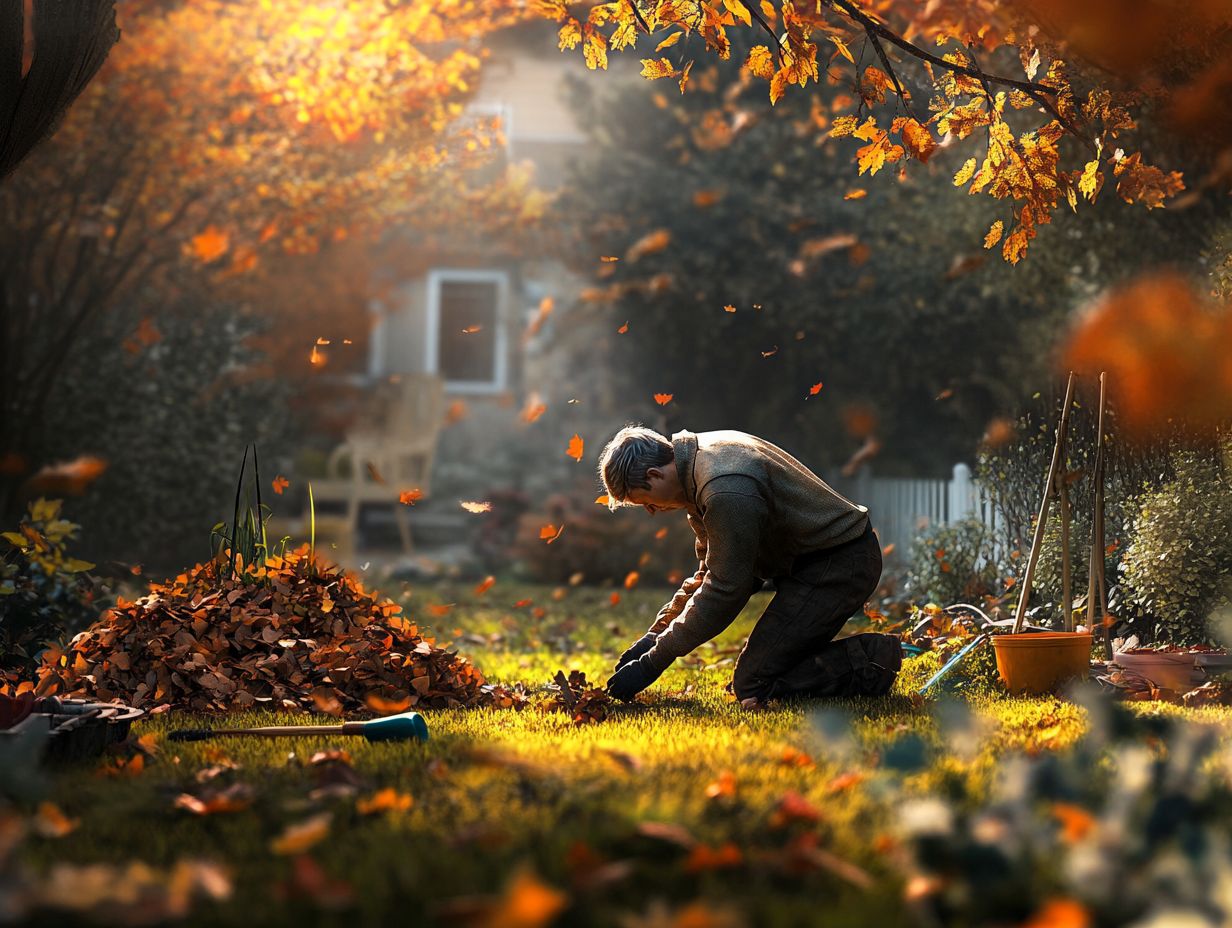
Seasonal garden clean-up is the process of preparing your garden for the changing weather and upcoming growing season. It involves removing debris, dead plants, and other unwanted materials from your garden to promote healthy growth and maintain a tidy appearance.
When should I start my seasonal garden clean-up?
The timing of seasonal garden clean-up can vary depending on your location and the type of plants in your garden. However, it is generally recommended to start in late fall or early winter before the ground freezes. This allows enough time for the clean-up process and gives your garden a fresh start for the spring.
What tools do I need for seasonal garden clean-up?
Some essential tools for seasonal garden clean-up include gloves, pruners, a hand trowel, a rake, and a wheelbarrow or garden cart. These tools will help you remove debris, trim plants, and transport materials effectively.
Depending on the size and type of your garden, you may need additional tools, such as hedge trimmers or a leaf blower.
How do I dispose of the debris collected during seasonal garden clean-up?
The best way to dispose of garden debris is to compost it. Composting is a fantastic way to turn waste into rich soil! If you do not have a compost bin, you can also dispose of the debris in your city’s green waste collection program or take it to a local composting facility.
Do I need to remove all plant debris during seasonal garden clean-up?
No, it is not necessary to remove all plant debris during seasonal garden clean-up. Some plant material, such as leaves, can provide insulation and protection for your garden during the winter months. However, remove diseased or pest-infested plants, as they can spread problems.
How Often Should I Do Seasonal Garden Clean-Up?
You should aim to clean your garden at least twice a year, in spring and fall. This helps keep your plants healthy and your garden looking great.
Depending on your plants and local weather, you might need to clean more often. Regular care will ensure your garden thrives throughout the seasons!



